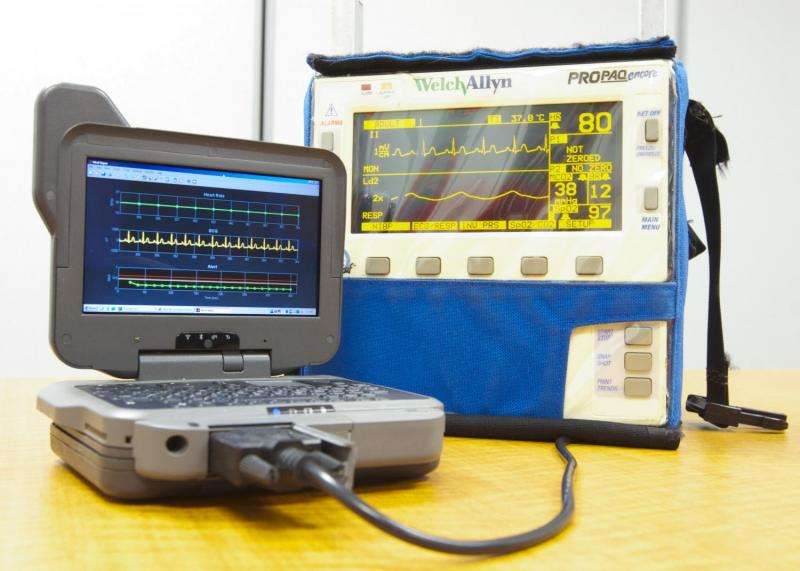Computerized vital signs analysis may help prevent trauma patients from bleeding to death

Automated analysis of the vital signs commonly monitored in patients being transported to trauma centers could significantly improve the ability to diagnose those with life-threatening bleeding before they arrive at the hospital, potentially saving their lives. In the May issue of the journal Shock, a research team from Massachusetts General Hospital (MGH), the U.S. Army, air ambulance service Boston MedFlight, and two other Boston trauma centers report successful field testing of a system that simultaneously analyzed blood pressure, heart rate, and breathing patterns during emergency transport, finding that it accurately detected most cases of life-threatening bleeding in a fully automated fashion.
"Providing faster care to patients who are bleeding to death saves lives," says Andrew Reisner, MD, MGH Department of Emergency Medicine and senior author of the Shock paper. "While the clinical information that ambulance crews call in to trauma centers was sufficient to determine the presence of a life-threatening hemorrhage in about half the patients we studied, many other patients were in a 'grey area' and may or may not have been at risk of bleeding to death. Our study demonstrated that automated analysis of patients' vital signs during prehospital transport was significantly better at discriminating between patients who did and did not have life-threatening hemorrhage. Receiving more reliable information before the patient arrives can help hospitals be ready for immediate surgery and replenishment of lost blood without wasting time and resources on false alarms."
Study corresponding author Jaques Reifman, PhD, U.S. Army Medical Research and Materiel Command (USAMRMC), adds, "This system provides an automated indicator of injury severity, an objective way for clinicians to prioritize care. Care prioritization or triage is a very important problem in military medicine, when there may be more injured casualties than caregivers. In those situations the ability to wisely choose who needs priority care is truly a matter of life and death."
While teams transporting patients either by air or ground ambulance regularly notify receiving hospitals of potentially deadly injuries, the information transmitted may be too general to identify those at risk of life-threatening bleeding. Even when a patient is clearly at risk of serious blood loss, decisions about the need for surgical repair and blood transfusions may not be made until assessment is completed at the trauma center. To investigate whether computerized analysis of data being gathered by vital signs monitors during transport could identify patients with dangerous bleeding, the research team developed software based on statistical techniques currently used in stock market trading and manufacturing to determine whether particular data points represent real problems and not random fluctuations.
The system dubbed APPRAISE (Automated Processing of the Physiological Registry for Assessment of Injury Severity) - consisting of an ultracompact personal computer networked to a standard patient monitor - was installed in two MedFlight helicopters and collected data on more than 200 trauma patients transported to participating Boston hospitals from February 2010 to December 2012. In order that patient care not be affected by a still-unproven system, the analysis conducted by the APPRAISE system was not provided to MedFlight crews. The researchers also analyzed data gathered in a 2005 study of vital sign data gathered manually by a Houston-based air ambulance system. Outcomes information for both patient groups was gathered by chart review.
In both groups, the pattern-recognition capability provided by the APPRAISE system - which was able to simultaneously combine measures of blood pressure with those of heart rate, breathing and the amount of blood pumped with each heartbeat - successfully identified 75 to 80 percent of patients with life-threatening bleeding, compared with 50 percent who were identified by standard clinical practice. Notifications provided by the system would have been available within 10 minutes of initial monitoring and as much as 20 to 40 minutes before patients arrival at the trauma centers.
"The fact that decisions to proceed with surgery or to replenish lost blood often occur only after patients' arrival means there are delays - sometimes brief but sometimes prolonged - in initiating such life-saving interventions," says Reisner, an assistant professor of Emergency Medicine at Harvard Medical School. "We are now working on a follow-up study to use this system in actual trauma care and will be measuring whether it truly leads to faster treatment of life-threatening hemorrhage and better patient outcomes. This approach could also be helpful for patients transported by ground ambulance and for hospitalized patients at risk of unexpected hemorrhage, such as during recovery from major surgery."
Reifman adds, "Uncontrolled bleeding is the single most important cause of preventable combat death among our troops, and the first challenge of combat casualty care is to identify who is and who isn't bleeding to death so that available resources can be concentrated on those who most need aid. Evacuation and treatment of injured soldiers can be challenging in locations where active fighting or other hazardous conditions are present, and first responders may be inexperienced, distracted or exhausted. The APPRAISE system's automated, objective assessment of vital signs would rationally determine who needs priority care during military operations."















